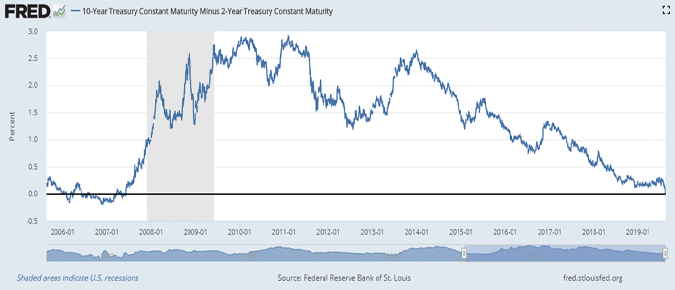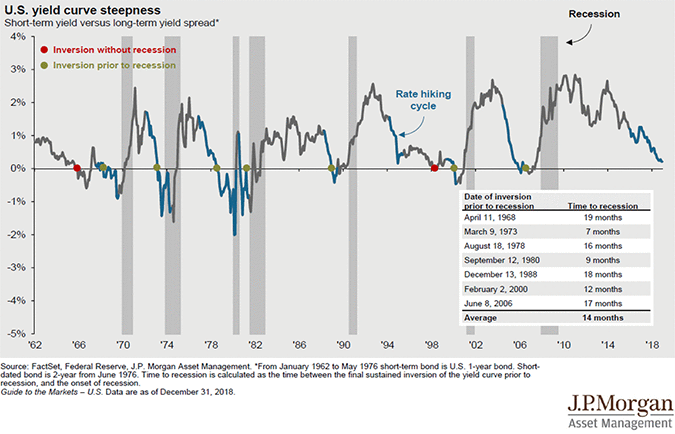CKBlog: Strategies
Tuesday, August 27, 2019
Don’t Let The Inverted Yield Curve Invert Your Investment Plan
by Steve Haberstroh, Partner
It’s been impossible to avoid recent headlines about the “Yield Curve Inversion” and why it means you should panic. Before you panic, let’s address the following questions: What is an Inverted Yield Curve? Does it mean a recession is coming? Should you sell your stocks now?
What is an Inverted Yield Curve?
From Bloomberg:
An inverted yield curve is an interest rate environment in which long-term debt instruments have a lower yield than short-term debt instruments of the same credit quality. This type of yield curve ... is considered to be a predictor of economic recession ... “
Under “normal” circumstances, long-term bonds tend to have higher yields than short-term bonds because a growing economy means prices should go up over time, reflecting the time value of money (also called “inflation”). So if short-term bonds yield more than long-term bonds, it suggests that investors are expecting the economy to slow, or worse, contract. If the economy contracts for two consecutive quarters, it’s called a recession. Stocks don’t like recessions.
So why all the headlines about inversions and recessions recently? As you can see from the chart below, the yield of the US government ten year bond dipped below the yield of the two year Wednesday, August 14th for the first time since 2007. The S&P 500 Index dropped by roughly 3% that day as investors feared a recession is looming.

Source: St. Louis Federal Reserve
Does it mean a recession is coming?
From our 2018 Annual Review on this very question:
Without getting into the weeds, history tells us that when the yields of long-dated bond drop below the yields of short-dated bonds a recession follows. True. Sort of.
Since 1962, there have been nine such inversions. Recessions occurred after seven of those, or 78% of the time—a decent rate. But this “rule” tells us nothing about WHEN the recession might occur after the inversion nor does it say anything about the stock performance that might follow.
So the rule doesn’t always work. And even when it does, it doesn’t tell us when recessions might occur? Not exactly a sure-fire stock trading signal.
Why is the yield curve inverted?
It is important to review why the yield curve is negative today and whether the reasons for it differ from historical inversions. Typically a yield inversion occurs when the underlying economy is too hot indicating that demand for goods is outstripping supply and wage gains exceed inflation. These indications and others cause the Federal Reserve (Fed) to increase rates and reduce the amount of money circulating, to put the brakes on the economy. These actions by the Fed are very hard to fine tune and usually cause the economy to contract (to go into recession).
I cringe when someone says “This time is different,” but in this case, it is likely different. For starters, the Fed just reduced short-term rates by 25 basis points. Long-term rates also fell, indicating high demand for US Dollar denominated long-term debt. Rates in the US and abroad are at historically low levels with many developed country yields being negative! Therefore it may be true that this rate inversion is not typical of the historical inversions.
Should you sell your stocks now?
If a headline about something as complicated and nuanced as the “Yield Curve Inversion” causes you to sell stocks, you shouldn’t own stocks in the first place. But if most inversions result in recessions and if stocks don’t like recessions, why not sell now?
As it turns out, stocks historically have performed well following a yield curve inversion. Stocks only sold off once the recession actually arrived. Who knew? Via Ben Carlson’s, “A Wealth of Common Sense” blog:

Source: A Wealth of Common Sense - Yield Curve Inversions Aren’t Great For Stocks
Bottom Line
It is true that the yield curve just inverted. And most of the time, this signals a recession is coming. The trouble is that by definition, we won’t know we’re in a recession until after the fact. And yes, stocks don’t like recessions but if history is any guide, stocks tend to perform well up until the recession actually hits. So what is an investor to do with all of this?
If your objective is to compound wealth over decades, you will need to hold stocks ... for decades. And yes, even during recessions. So unless your crystal ball tells us the recession is here and it knows when it will end, I wouldn’t let a yield curve inversion cause your investment strategy to invert.





